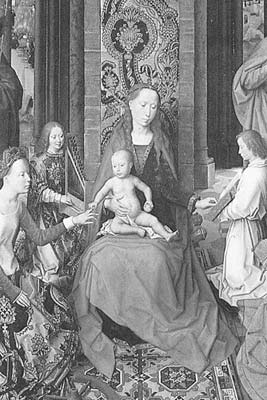
Memling in Sint-Jan Hospitaalmuseum
Located in the former hospital wards and church of St. John’s Hospital, the Memling Museum offers a glimpse into medieval medicine, displaying surgical instruments, documents, and visual aids as you work your way to the museum’s climax: several of Hans Memling’s glowing masterpieces.
Cost: €8, includes good audioguide and free loaner folding chairs (if you’d like to sit and study the paintings).
Hours: Tue-Sun 9:30-17:00, closed Mon, last entry 30 minutes before closing.
Getting There: The museum is at Mariastraat 38, across the street from the Church of Our Lady.
Information: Bruges museums tel. 050-448-713, www.brugge.be.
Length of This Tour: Allow one hour.
Hans Memling’s art was the culmination of Bruges’ Flemish Primitive style. His serene, soft-focus, motionless scenes capture a medieval piety that was quickly fading. The popular style made Memling (c. 1430-1494) one of Bruges’ wealthiest citizens, and his work was gobbled up by visiting Italian merchants, who took it home with them, cross-pollinating European art.
The displays on medieval medicine are all on one floor of the former sick hall, with the Memlings in a chapel at the far end.
Some 500 years ago, Bruges was a major destination for pilgrims. People both healthy and frail trekked here from all over this part of Europe to see the relic of the blood of Christ (at the Church of the Holy Blood). Many were or became ill and had to be cared for. And that’s what this building was all about.
The building itself, which has housed a hospital since 1188, is impressive. It grew in importance as the precious relic of the holy blood grew in notoriety. This hall was lined with beds filled with the sick and dying. Nuns served as nurses. At the far end was the high altar, which once displayed Memling’s St. John Altarpiece (which we’ll see). Bedridden patients could gaze on this peaceful, colorful vision and gain a moment’s comfort from their agonies.
A painting by Jan Beerblock, De Oude Ziekenzalen (1778), gives an intimate peek at “the old sick hall” in action. Study it for a sense of what it was like. The soup’s on, dogs are welcome, a nun administers last rites, the sedan chair ambulance taxi awaits a patient (an actual sedan chair ambulance still stands nearby). Snacks and drinks are served in bed. The floor needs mopping. A VIP clergyman drops in to see that all’s OK.
As the museum displays make clear, medicine of the day was well-intentioned but very crude. In many ways, this was less a hospital than a hospice, helping the dying make the transition from this world to the next. Religious art (displayed further along in the museum) was therapeutic, addressing the patients’ mental and spiritual health. The numerous Crucifixions reminded the sufferers that Christ could feel their pain, having lived it himself.

• Continue through the displays of religious art—past paintings that make you thankful for modern medicine. Head through the wooden doorway to the black-and-white tiled room where Memling’s paintings are displayed. A large triptych (three-paneled altarpiece) dominates the space.
Sick and dying patients lay in their beds in the hospital and looked at this colorful, three-part work, which sat atop the hospital/church’s high altar. The piece was dedicated to the hospital’s patron saints, John the Baptist and John the Evangelist (see the inscription along the bottom of the frame), but Memling broadened the focus to take in a vision of heaven and the end of the world.

Central Panel: Mary, with baby Jesus on her lap, sits in a canopied chair, crowned by hovering blue angels. It’s an imaginary gathering of conversing saints (Sacra Conversazione), though nobody in this meditative group is saying a word or even exchanging meaningful eye contact.
Mary is flanked by the two Johns—John the Baptist to the left, and John the Evangelist (in red) to the right. Everyone else sits symmetrically around Mary. An organist angel to the left is matched by a book-holding acolyte to the right. St. Catherine (left, in white, red, and gold) balances St. Barbara, in green, who’s absorbed in her book. Behind them, classical columns are also perfectly balanced left and right.
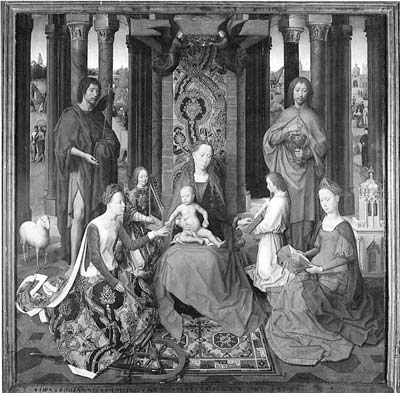
At the center of it all, baby Jesus tips the balance by leaning over to place a ring on Catherine’s finger, sealing the “mystical marriage” between them.
St. Catherine of Alexandria, born rich, smart, and pagan to Roman parents, joined the outlawed Christian faith. She spoke out against pagan Rome, attracting the attention of the emperor, Maxentius, who sent 50 philosophers to talk some sense into her—but she countered every argument, even converting the emperor’s own wife. Maxentius killed his wife, then asked Catherine to marry him. She refused, determined to remain true to the man she’d already “married” in a mystical vision—Christ.
Frustrated, Maxentius ordered Catherine to be stretched across a large, spiked wheel (the rather quaint-looking object at her feet), but the wheel flew apart, sparing her and killing many of her torturers. So they just cut her head off, which is why she has a sword, along with her “Catherine Wheel.”
Looking through the columns, we see scenes of Bruges. Just to the right of the chair’s canopy, the wooden contraption is a crane, used to hoist barrels from barges on Kraanplein.
Left Panel—The Beheading of John the Baptist: Even this gruesome scene, with blood still spurting from John’s severed neck, becomes serene under Memling’s gentle brush. Everyone is solemn, graceful, and emotionless—including both parts of the decapitated John. Memling depicts Salomé (in green) receiving the head on her silver platter with a humble servant’s downcast eyes, as if accepting her role in God’s wonderful, if sometimes painful, plan.

In the background, left, we can look into Herod’s palace, where he sits at a banquet table with his wife while Salomé dances modestly in front of him. Herod’s lust is only hinted at with the naked statues—a man between two women—that adorn the palace exterior.
Right Panel—John the Evangelist’s Vision of the Apocalypse: John sits on a high, rocky bluff on the island of Patmos and sees the end of the world as we know it...and he feels fine.
Overhead, in a rainbow bubble, God appears on his throne, resting his hand on a sealed book. A lamb steps up to open the seals, unleashing the awful events at the end of time. Standing at the bottom of the rainbow, an angel in green gestures to John and says, “Write this down.” John starts to dip his quill into the inkwell (his other hand holds the quill-sharpener), but he pauses, absolutely transfixed, experiencing the Apocalypse now.
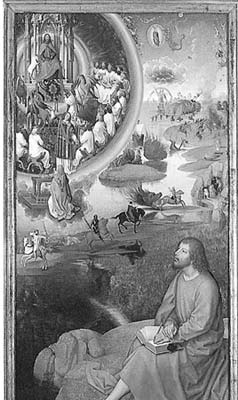
He sees wars, fires, and plagues on the horizon, the Virgin in the sky rebuking a red dragon, and many other wonders. Fervent fundamentalists should bring their Bibles along, because there are many specific references brought to life in a literal way.
In the center ride the dreaded Four Horsemen, wreaking havoc on the cosmos (galloping over either islands or clouds). Horseman number four is a skeleton, followed by a humaneating monster head. Helpless mortals on the right seek shelter in the rocks, but find none.
Memling has been criticized for building a career by copying the formulas of his predecessors, but this panel is a complete original. Its theme had never been so fully expressed, and the bright, contrasting colors and vivid imagery are almost modern. In the St. John Altarpiece, Memling shows us the full range of his palette, from medieval grace to Renaissance symmetry, from the real to the surreal.
• In a glass case, find the...
On October 21, 1489, the mortal remains of St. Ursula were brought here to the church and placed in this gilded oak shrine, built specially for the occasion and decorated with paintings by Memling. Ursula, yet another Christian martyred by the ancient Romans, became a sensation in the Middle Ages when builders in Germany’s Köln (Cologne) unearthed a huge pile of bones believed to belong to her and her 11,000 slaughtered cohorts.
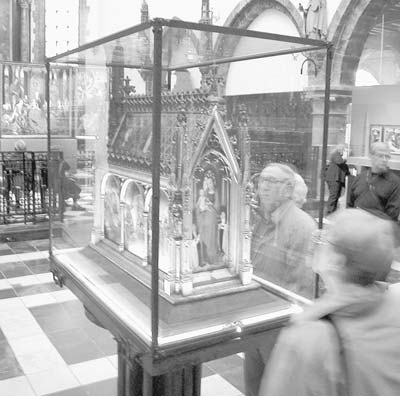
The shrine, carved of wood and covered with gold, looks like a miniature Gothic church (similar to the hospital church). Memling was asked to fill in the “church’s” stained-glass windows with six arch-shaped paintings describing Ursula’s well-known legend.
• Stand with your back to the wall, facing the shrine. “Read” the shrine’s story from left to right, circling counterclockwise, but begin with the...
Left Panel: Ursula—in white and blue—arrives by boat at the city of Köln and enters through the city gate. She’s on a pilgrimage to Rome, accompanied by 11,000 (female) virgins. That night (look in the two windows of the house in the background, right), an angel appears and tells her this trip will mean her death, but she is undaunted.
Center Panel: Continuing up the Rhine, they arrive in Basel. (Memling knew the Rhine, having grown up near it.) Memling condenses the 11,000 virgins to a more manageable 11, making each one pure enough for a thousand. From Basel they set out on foot (in the background, right) over the snowy Alps.
Right Panel: They arrive in Rome—formally portrayed by a round Renaissance tower decorated with putti (little angels)—where Ursula falls to her knees before the pope at the church steps. Kneeling behind Ursula is her fiancé, Etherus, the pagan prince of England. She has agreed to marry him only if he becomes a Christian and refrains from the marriage bed long enough for her to make this three-year pilgrimage as a virgin (making, I guess, number 11,001). Inside the church, on the right side, he is baptized a Christian.
Opposite Side—Left Panel: They head back home. They’re leaving Basel, boarding ships to go north on the Rhine. The pope was so inspired by these virgins that he joined them. These “crowd” scenes are hardly realistic—more like a collage of individual poses and faces. And Memling tells the story with extremely minimal acting. Perhaps his inspiration was the pomp and ceremony of Bruges parades, which were introduced by the Burgundian dukes. He would have seen tableaux vivants, where Brugeois would pose in costume like human statues to enact an event from the Bible or from city history. (Today’s “living Christmas crèches” carry on this medieval art form.)
Middle Panel: Back in Köln, a surprise awaits them—the city has been taken over by vicious Huns. They grab Etherus and stab him. He dies in Ursula’s arms.
Right Panel: The Hun king (in red with turban and beard) woos Ursula, placing his hand over his heart, but she says, “No way.” So a Hun soldier draws his arrow and prepares to shoot her dead. Even here, at the climax of the story, there are no histrionics. Even the dog just sits down, crosses his paws, and watches. The whole shrine cycle is as posed, motionless, and colorful as the tableaux vivants that may have inaugurated the shrine here in this church in 1489.
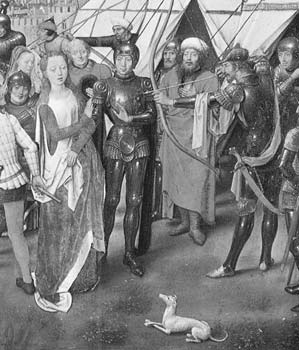
In the background, behind Ursula, a Bruges couple looks on sympathetically. This may be Memling himself (in red coat with fur lining) and his wife, Anna, who bore their three children. Behind them, Memling renders an accurate city skyline of Köln, including a side view of the Köln Cathedral (missing its still-unfinished tall spires).
• In the small adjoining room, find more Memlings.
Three-dimensional effects—borrowed from the Italian Renaissance style—enliven this traditional two-panel altarpiece. Both Mary and Child and the 23-year-old Martin, though in different panels, inhabit the same space within the painting.
Stand right in front of Mary, facing her directly. If you line up the paintings’ horizons (seen in the distance, out the room’s windows), you’ll see that both panels depict the same room—with two windows at the back and two along the right wall.
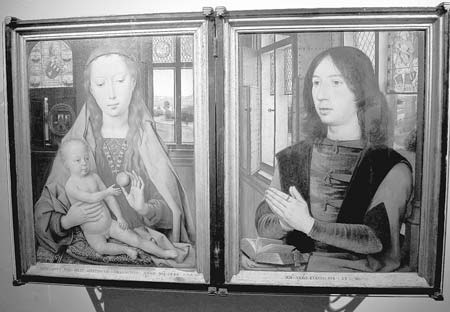
Want proof? In the convex mirror on the back wall (just to the left of Mary), the scene is reflected back at us, showing Mary and Martin from behind, silhouetted in the two “windows” of the picture frames. Apparently, Mary makes house calls, appearing right in the living room of the young donor Martin, the wealthy, unique-looking heir to his father’s business.
• Before leaving this area, find, to your right, a...
Memling’s bread-and-butter was portraits created for families of wealthy merchants (especially visiting Italians and Portuguese). This portrait takes us right back to that time.
The young woman looks out of the frame as if she were looking out a window. Her hands rest on the “sill,” with the fingertips sticking over. The frame is original, but the banner and Van Eyck-like lettering are not.

Her clothes look somewhat simple, but they were high-class in their day. A dark damask dress is brightened by a red sash and a detachable white collar. She’s pulled her hair into a tight bun at the back, pinned there with a fez-like cap and draped with a transparent veil. She’s shaved her hairline and plucked her brows to get that clean, high-forehead look. Her ensemble is animated by a well-placed necklace of small stones.
Memling accentuates her fashionably pale complexion and gives her a pensive, sober expression, portraying her like a medieval saint. Still, she keeps her personality, with distinct features like her broad nose, neck tendons, and realistic hands. She peers out from her subtly painted veil, which sweeps down over the side of her face. What’s she thinking? (My guess: “It’s time for a waffle.”)